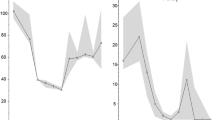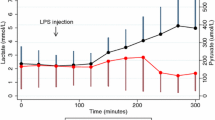Abstract
We have used two different experimental models to examine the relationship between local cerebral blood flow and metabolism in hydrocephalus. In our first experiments local cerebral blood flow (LCBF) and local cerebral glucose utilization (LCGU) were measured by quantitative autoradiographic methods in adult rats rendered hydrocephalic, though asymptomatic, by the injection of kaolin intracisternally at 3 weeks of age and in control animals. There were no significant differences in LCGU or LCBF in any of the 29 areas of grey matter examined, including layer IV of the cerebral cortex. Scanning across the cerebral cortex revealed an appreciable fall in LCGU and LCBF towards the inside and the outside of the mantle in control animals. Hydrocephalus had no significant effect on this “transmantle” pattern of reduction in cortical metabolism towards the periphery, but in contrast, significantly enhanced the reduction in cortical blood flow in 7 out of the 10 cortical regions examined. Hence, in this model of asymptomatic hydrocephalus there is relative uncoupling of LCBF and LCGU in the inner and outer layers of the cerebral mantle. In a study performed in congenitally hydrocephalic H-Tx rats at 10, 20 and 28 days we found that uptake of deoxyglucose was impaired in hydrocephalic rats compared with their non-hydrocephalic siblings. Small changes were seen at 10 and 21 days, but statistically significant changes were seen only at 28 days. A small reduction in LCBF was observed in all regions at 10 days, with statistically significant differences between control and hydrocephalic rats in auditory and parietal cortex. By 21 days, reductions of between 25% and 70% in local cerebral blood flow were observed in all regions, with statistically significant differences in visual, auditory and parietal cortex. At 30 days, a statistically significant difference was found between controls and hydrocephalic rats in pons, caudate nucleus and visual, auditory, parietal and sensorimotor cortex. This second study indicates that decreases in local cerebral blood flow precede decreases in cerebral metabolism and occur before the appearance of obvious symptoms. Our experiments suggest that in hydrocephalus a decrease in tissue perfusion precedes any impairment of cerebral glucose metabolism and may occur before the appearane of any gross symptoms.
Similar content being viewed by others
References
Bucknall RM, Richards HK, Jones HC, Pickard JD (1991) Cerebral blood flow in the congenitally hydrocephalic H-Tx rat. J Cereb Blood Flow Metab 11 [Suppl 2]: S66
Jones HC, Bucknall RM (1988) Inherited prenatal hydrocephalus in the H-Tx rat: a morphological study. Neuropathol Appl Neurobiol 14: 263–274
Jones HC, Richards HK, Bucknall RM, Pickard JD (1993) Local cerebral blood flow in rats with congenital hydrocephalus. J Cereb Blood Flow Metab 13: 531–534
Patlak CS, Blasberg RG, Fenstermacher JD (1984) An evaluation of errors in the determination of blood flow by the indicator fractionation and tissue equilibrium (Kety) methods. J Cereb Blood Flow Metabol 4: 47–68
Pickard JD, Richards HK (1987) Uncoupling of blood flow and metabolism in the inner and outer layers of the cerebral mantle in experimental hydrocephalus in the rat. J Physiol (Lond) 392: 55P
Reivich M, Jehle J, Sokoloff L, Kety SS (1969) Measurement of regional cerebral blood flow with antipyrine-14C in awake cats. J Appl Physiol 27: 296–300
Richards HK, Lovick AHJ, Pickard JD (1985) A low-cost microcomputerbased densitometer. J Cereb Blood Flow Metab 5: 481–482
Richards HK, Lovick AHJ, Pickard JD (1987) A modification of the method for the measurement of cerebral blood flow using [14C]Iodoantipyrine in small animals. J Cereb Blood Flow Metab 7: 124–126
Richards HK, Bucknall RM, Jones HC, Pickard JD (1989) The uptake of [14C]-deoxyglucose into brain of young rats with inherited hydrocephalus. Exp Neurol 103: 194–198
Sakurada O, Kennedy C, Jehle J, Brown JD, Carbin GL, Sokoloff L (1978) Measurement of local cerebral blood flow with iodo[14C]antipyrine. Am J Physiol 234: H59-H66
Sokoloff L, Reivich M, Kennedy C, Des Rosiers MH, Patlak CS, Pettigrew KD, Sakurada O, Shinohara M (1977) The (14C) method for the measurement of local cerebral glucose utilization: theory, procedure and normal values in the conscious and anesthetized albino rat. J Neurochem 28: 897–916
Author information
Authors and Affiliations
Rights and permissions
About this article
Cite this article
Richards, H.K., Bucknall, R.M., Jones, H.C. et al. Uncoupling of LCBF and LCGU in two different models of hydrocephalus: a review. Child's Nerv Syst 11, 288–292 (1995). https://doi.org/10.1007/BF00301762
Issue Date:
DOI: https://doi.org/10.1007/BF00301762




